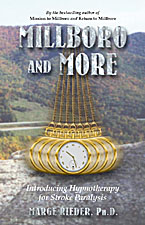 Millboro and More
Millboro and More Millboro and More
Millboro and MoreIntroducing Hypnotherapy for Stroke Paralysis
Marge Rieder, Ph.D., has written two earlier books, Mission to Millboro and Return to Millboro, which have explored the amazing Civil War story that emerged from her regression of many subjects using hypnotherapy. Millboro and More follows a few more threads from that story, as Rieder searches for physical evidence that will verify the characters and places that her subjects so vividly described.
Millboro and More also explores interesting new aspects of hypnosis and innovative applications. Continuing her interest in past-life regression, Rieder comes up with some surprising answers to some unusual questions, such as:
Rieder also explores therapeutic uses for hypnotherapy to help us during this life:
|
Table of Contents |
1. Robin's Nest
Warm Springs Inn
Supplies for Gettysburg?
2. The Confederate White House
3. Millboro
4. The Big White Rock
5. Hypnosis
6. Controlling the Emotions with Hypnosis
7. Confidence
8. A Close Look at Homosexuality
9. Life in the Womb
10. Twin Study
11. Phantom Limb Pain
12. Spirit Releasment
13. Utilizing the Power of the Unconscious Mind
14. A Baby for Queen Christina
15. Stroke Strategy
The Nervous System
Ernie Adams
Bob Jenkins
Walter Hopp
June Baca
Ray Conniff
Diane Bingham
Madelina de Paz
Secondary Gain
Suggestions for Stroke Subjects
Afterword
Bibliography
|
Excerpt |
Afterword
After risking life and limb searching for the entrance to the cave in the mountains above Millboro, I judiciously decided to give the Millboro story a rest. Perhaps, given time, a group of explorers more skilled in the art of spelunking will find a way into the cavern. The Millboro research has covered a span of approximately seventeen years.
As a veteran of WWII, for a while I was a member of the American Legion. One Memorial Day, I accompanied a group of veterans to a local veteran's hospital. I understand that there are many cases of phantom limb pain in V.A. hospitals. While talking to the administrator, I volunteered to spend one afternoon a week working, at no charge, with veterans in pain. Despite the fact that I should be used to it, his reaction stunned me. He was horrified that I would suggest such a thing and furthermore, the government would never stand for it for a minute. The impression I got was that he was about to bodily throw me out of the facility, so I left. A few weeks later, a friend of mine told me about her cousin, a patient at the Long Beach Veteran's Hospital who, after beseeching the doctors to perform several additional surgeries on the stump of a leg that had been amputated, finally, in desperation, shot and killed himself to escape the phantom pain that tormented him.
Many of the stories in this book were researched as much as thirty years ago. The homosexual study reinforces ideas with us today. Gay people do not want to change their orientation, do not want anyone attempting to change them. They are, however, extremely interested and curious about what it is that makes them gay. Why do they have brothers and sisters that are perfectly "normal"? The one outstanding point upon which they all agree is that the gay orientation is innate. None of them ever consciously chose to be gay.
The twin study strongly indicates to me that John Locke's theory of the "tabula rasa," that the mind is a blank slate at birth, is erroneous. In fact, throughout the thirty years I have worked with hypnosis, I am continually amazed at the interesting, sometimes colorful, weird and wonderful things that are buried deeply in all our minds-things that had to be there at birth, as none of us could have lived, in this lifetime, long enough to have amassed such a storehouse of information. Let me reiterate that this work indicates that only identical twins appear to be hiding the same past-life memories. Work with fraternal twins disclosed that they share some past lifetimes but not all.
Bringing my daughter through her birth, hearing her describe the experience step by step from the fetus' point of view was very engrossing as I was so personally involved in the entire process. I was not aware that her feet had actually started out of the birth canal and had been forced back into my body by the doctor. But I do vividly recall the reaction in the room. Suddenly all was chaos, nurses and interns rushing into the room, metal tables bearing instruments clanging into the room, frantic activity everywhere.
The "stroke" work is a concept that has been dancing about in the back of my mind for many years. When I first learned that one could direct an entranced subject to unwittingly raise a hand or arm (or foot) into the air by manipulating his autonomic nervous system, I immediately wondered if this would work with a stroke victim. Finally, I tried it and the results are as I portrayed them in the book....
Because the results of the work with stroke patients has been so gratifying, it is my intention to continue down this avenue. Perhaps others, paralyzed by something other than a stroke can be helped in a similar fashion. It is certainly worth looking into.
Blue Dolphin Publishing, 2003